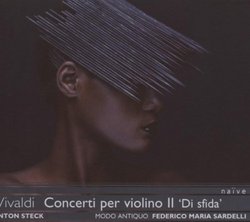Fantastic Virtuoso Music from Vivaldi
Andrew Judkins | 10/18/2008
(5 out of 5 stars)
"Di Sfida, roughly translated, means `the challenge' and the theme of this album is to point out the merits of virtuosity in Vivaldi violin concerti. Vivaldi is one of the most prolific composers of violin music, with his output of violin concerti at around 250. He wrote for a wide variety of players and levels, being a teacher, but his works tend to have a very high standard of playing overall. The concerti of this volume were most likely written for Vivaldi himself or other virtuosos of the time. Vivaldi began composing virtuoso works for the violin early in his career. His first peak, from this perspective, was in the area of 1712-1717. During this time he wrote out cadenzas that astounded his contemporaries. This album includes later works of high virtuosity, a period in which Vivaldi shied away from the cadenza, yet more smoothly incorporated extreme virtuosity into his artistic vision. The works here, possibly, the B flat major RV 368 aside, use virtuosity as a tool of expression, not as means to shock for its own sake. They are elaborate, highly original, and artistically ahead of their time. Anton Steck is fantastic as the soloist who, although not as polished or artistically vibrant as say, Guliano Carmignola, brings a brilliant enthusiasm for the music. He is able to tackle all of the toughest moments smoothly, only scrimping in a few pinpoints on the B flat major concerto. Modo Antiquo is a fine baroque orchestra with energy approaching Steck's. The sound of the ensemble is a little dry and distant compared to the soloist, however. The works included are:
RV 232 in D major. This concerto is a parade of brilliance, and one of Vivaldi's best concertos. The standard of virtuosity is very high throughout. The concentration of musical ideas and spontaneity of writing is impressive. The slow movement is oddly arresting between the dashing, audacious outer movements. All three movements are fantastic.
RV 264 in E major. This piece has a jovial, humorous tone. Vivaldi includes dance rhythms and unexpected turns to charm the listener. The slow movement is slight, but starkly beautiful.
RV 325 in G minor. Minor key harmony is a welcome contrast here. Vivaldi's G minor is turbulent, with gaps of melancholy. This concerto is probably the oldest work on this album and it has a rustic feel. This recording, though good, is not as dynamic as Carmignola's version.
RV 353 in A major. Much more modern in sound, this concerto feels like the beginning of Rococo aesthetic. There are cantabile passages, mixed with angular and speedy ones, all garishly garnished, creating an almost satiric tone at times. But overall it is a pleasant piece as evidenced by its short, song-like slow movement.
RV 243 in D minor. This concerto requires the violinist to not use the E string and tune up the G string to A. An already difficult work becomes extremely so with the omission of the E string. Far from an empty (though novel) exercise in virtuosity, this requirement creates a muted plaintive tone that fits perfectly with the material. The slow movement will disarm you.
RV 368 in B flat major. This work is a fitting closer. It is reported to be Vivaldi's most difficult work-the harbinger of Paganini. The violinist is required to move between ranges with the quickest ease, and the almost bizarre arpeggiation, spanning all four strings, push the bow and fingers to the limit. The orchestral part is slick and disarming, not preparing the listener for the thoroughly entertaining solos. This piece is a must have for any Vivaldi fan, and I am unaware of another recording of it. This CD is highly recommended."


 Track Listings (18) - Disc #1
Track Listings (18) - Disc #1